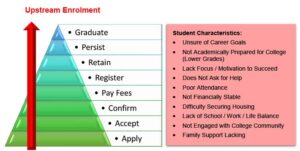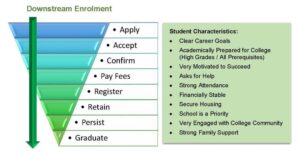Upstream and Downstream Students
Posted on Monday, April 24th, 2023
In his best-selling book, author Dan Heath, writes about the upstream challenges many organizations face when they choose to tackle tough systemic issues to help the most vulnerable people in society. It’s a concept that can be applied to student success when you consider the great challenges some of our students face when they choose to better themselves by accessing post-secondary education.
Much of the work we do with students can be categorized as upstream. Moving prospective students through the admission funnel and preventing them from melting away before classes start is upstream work. So is retaining them after they start classes by not only providing them with additional supports but ensuring they access this help.
When you consider why students leave the college before completing their programs, in many cases the behaviour is predictable. We have access to a lot of data that helps us understand who our students are while they are still in the admissions funnel. For example, a student who just meets our admissions requirements is considered a higher risk of not being successful, because their high school transcript is an early indicator that they may struggle in some academic courses.

(When we are working with upstream students, any or all of these student characteristics can apply)
A student who self identifies that they are not sure they are in the right program or is concerned about being able to pay for their educational investment, also presents risk factors. An out of town student, who displays signs of home sickness, is also vulnerable to dropping out of school.
This is where the upstream work begins. The earlier we can intervene, by introducing retention strategies within the student recruitment funnel, the better position we will be in to help students succeed.
But doing upstream work isn’t as easy as applying downstream support. Students who are categorized as being in the downstream have clear career goals, they have the marks to succeed in college, they have family support and financial resources to pay their tuition and they have confidence in their abilities. These students move through the admissions and retention funnel easily and require limited interventions leading up to the start of classes and during their program of study.
The students who are swimming upstream in the admissions funnel are struggling and need reassurance they are making a good decision. If that support isn’t coming from their own network, it needs to come from the college. Early and intrusive interventions such as having them participate in campus tours, meeting a current student or faculty member to start building relationships, and engaging in academic preparation programming are good example of things the college can do to help these students stay the course in the admissions process.

(When we are working with downstream students, they move seamlessly through the student lifecycle from application to graduation.)
So, when we think of the admissions funnel, we need to consider both the upstream and downstream impact of the work we collectively do to support students. It’s easier to focus on downstream, but there aren’t enough students in this category to meet our enrolment aspirations, so we need to invest the time and energy with the upstream applicants to keep them moving through the funnel.
That takes a village. Our college values of caring, learning, integrity and respect guide our work in helping students who have an upstream pathway to attend college. They need us and we need them. A warm smile, an offer to help a student who isn’t sure where they should be going for support, or an invitation to participate in an orientation activity can go a long way in helping a student adjust to their new surroundings.
Collectively, college employees work together to provide a life jacket to students swimming in the upstream so they feel comfortable and supported that they are making the right decision, but upstream work doesn’t end with a few interactions with a student. It continues through their academic journey. That’s why it’s tough work, but the benefits to the college and particularly the student, are well worth the effort.
Author: Jamie Bramburger
- Posted in
- Strategic Enrolment Awareness